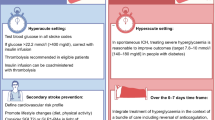Abstract
Background and purpose
Anti-inflammatory therapy decreases infarct size and enhances stroke recovery. Thiazolidinedione peroxisome proliferator-activated receptor (PPAR)gamma agonists have potent anti-inflammatory and insulin-sensitizing anti-diabetic actions.
Methods
Thirty stroke patients with type 2 diabetes admitted for acute inpatient stroke rehabilitation receiving pioglitazone or rosiglitazone were matched for age, sex, initial FIMTM score and interval post-stroke with 30 stroke patients with type 2 diabetes not receiving thiazolidinediones. Relevant outcome variables were compared for both groups.
Results
The thiazolidinedione treated group showed significantly greater mean improvement in FIMTM score compared to control group (25.6 ± 10.2 SD vs. 19.8 ± 10.5, respectively, P = 0.015). There was no significant difference in length of rehabilitation hospital stay (24.2 ± 7.6 vs. 25.1 ± 7.4 days, P = 0.657) or final discharge destination (home/institution, 19/11 versus 17/13, P = 0.792).
Conclusions
Use of thiazolidinediones was associated with enhanced functional recovery in stroke patients with type 2 diabetes.
Similar content being viewed by others
References
Kagansky N, Levy S, Knobler H (2001) The role of hyperglycemia in acute stroke. Arch Neurol 58:1209–1212
Dormandy J, Charbonnel B, Eckland D, Erdmann E et al. (2005) PROactive investigators. Secondary prevention of macrovascular events in patients with type 2 diabetes in the PROactive study (PROspective pioglitAzone Clinical Trial in macroVascular Events): a randomized controlled trial. The Lancet 366:1279–1289
Hsueh WA, Bruemmer D (2004) Peroxisome proliferator-activated receptor gamma: implications for cardiovascular disease. Hypertension 43:297–305
Reusch JE, Regensteiner JG, Watson PA (2003) Novel actions of thiazolidinediones on vascular function and exercise capacity. Am J Med 115:69S–74S
Sundararajan S, Landreth GE (2004) Anti-inflammatory properties of PPARgamma agonists following ischemia. Drug News Perspect 17:229–236
Dirnagl U, Iadecola C, Moskowitz MA (1999) Pathobiology of ischaemic stroke: an integrated view. Trends Neurosci 22:391–397
Iadecola C, Alexander M (2001) Cerebral ischemia and inflammation. Curr Opin Neurol 14:89–94
Zhang W, Stanimirovic D (2002) Current and future therapeutic strategies to target inflammation in stroke. Curr Drug Targets Inflamm Allergy 1:151–166
Sundararajan S, Gamboa JL, Victor NA, Wanderi EW, Lust WD, Landreth GE (2005) Peroxisome Proliferator-activated receptor-γ ligands reduce inflammation and infarction size in transient focal ischemia. Neuroscience 130:685–696
Acknowledgments
The authors thank Konkuk University, Seoul, South Korea, and the Stroke Rehabilitation Research Fund of Burke Rehabilitation Hospital for their support in the conduct, analysis and preparation of this manuscript in 2005.
Author information
Authors and Affiliations
Corresponding author
Additional information
Special issue dedicated to John P. Blass.
Rights and permissions
About this article
Cite this article
Lee, J., Reding, M. Effects of Thiazolidinediones on Stroke Recovery: A Case-Matched Controlled Study. Neurochem Res 32, 635–638 (2007). https://doi.org/10.1007/s11064-006-9138-3
Accepted:
Published:
Issue Date:
DOI: https://doi.org/10.1007/s11064-006-9138-3




